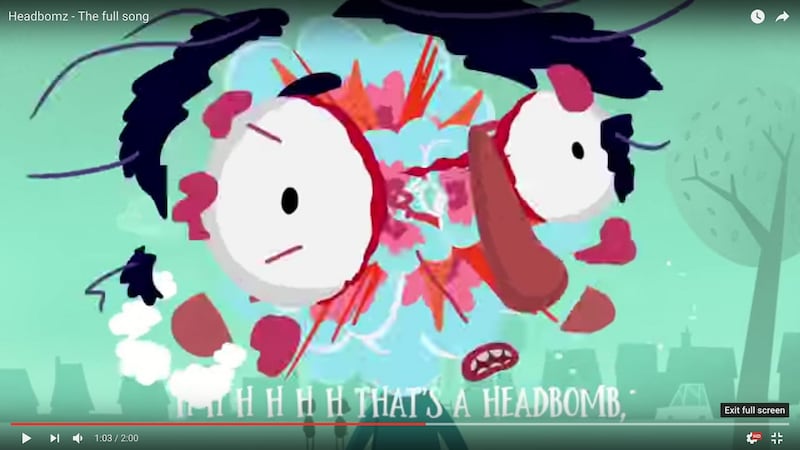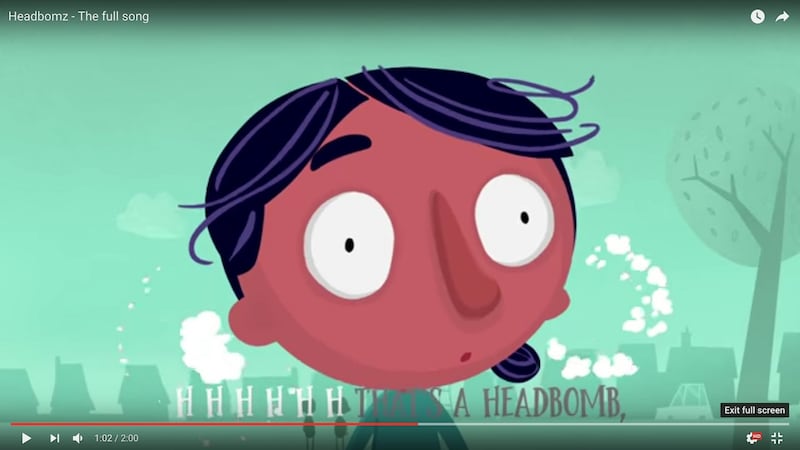The exploding head splatters all over the place: eyeballs bouncing, the nose on the ceiling, the brain in the “bog”. It’s the sort of grisly cartoon humour that appeals to many children approaching their first double-digit birthday.
You or your children may have seen this animated video, Headbomz, on TV or online. It's an awareness-raising campaign from Childline, the ISPCC's listening service, about the importance of talking about problems.
But it has been condemned by some professionals as too frightening for vulnerable children, who may take the message literally – that their heads will explode if they don’t talk.
The classy, two-minute animation was created by Aardman studios, best known as creators of Wallace and Gromit and Shaun the Sheep. "Talking makes us stronger and we'll keep our heads for longer," goes the children's song on the soundtrack.
The video encourages children to express their feelings to a parent, a teacher or other trusted adult. Or, indeed, Childline, which received more than 400,000 calls, texts and online contacts from children last year – that’s more than 1,000 a day.
The charity stands over Headbomz, which was created to connect with its target audience of eight- to 10-year-olds rather than adults, but it did decide to pull it from cinemas. A spokeswoman explains that on receiving complaints and taking further advice it was realised that when children see it, they want to talk about it immediately and that's not possible when it's followed by a 90-minute film in a cinema.

However, at the time of writing, it was intended to continue running the campaign on TV, online and in a schools programme for second to fourth class. But Caroline Quinn, principal of Our Lady of Good Counsel Girls’ National School in Johnstown, Co Dublin, is one who won’t be letting it into her classrooms.
“I fully applaud the philosophy and the principles behind the campaign; the execution of it I am shocked at,” she says. Aware of the increase in mental health problems, the school has been very proactive in bringing in programmes aimed at building children’s resilience but they all take a softer, serious approach.
While acknowledging Headbomz is colourful and catchy, Quinn worries about troubled children who might think they have no one to talk to and that their head will explode. "If the child is scared out of their wits at the cinema, they will be equally at home because a lot of children are spending time on their own watching TV or on their devices."
Galway play therapist Linsey McNelis is also worried about the effects the “vivid images” could have on younger children, on those already suffering from anxiety and those with autism who are inclined to think literally.
“I don’t think it is giving the message that they hoped for,” she says, pointing out that “talking” is not the only answer for expressing feelings. “As a play therapist, I see a lot of children who do not have the cognitive ability yet to talk and sometimes they need other mediums to show how they are feeling.”
Manchester bombings
However, she can see it could have merit in a supervised school setting for the designated age group, but not when played to all on TV or online. And although she had seen the cartoon and had concerns before the Manchester bombings, she does add that she doesn’t think the metaphor is a very good one to use at the moment. After the bombings, the campaign came off air immediately for a week.
The controversy around Headbomz illustrates the fine balance between capturing children's attention in an over-crowded media landscape and the risk of upsetting others' sensibilities.
"The kids love it," says a Childline spokeswoman, who reports lots of positive feedback both from children and parents on the campaign, which was developed in partnership with the Vodafone Ireland Foundation. "It is inspired by children's literature and we did a lot of research on how to connect with kids."
The specific targeting of eight- to 10-year-olds was also informed by research, which was led by social psychologist Karen Hand. The idea is to "start trying to build up a competence in resilience before they hit puberty", she explains. "A lot of the things they will have to deal with, on a bigger, more problematic level, happen in puberty."
An estimated 50 per cent of adult mental health problems begin before the age of 14, so clearly there’s a need for promotion of psychological well-being long before adolescence.
She likens it to developing a muscle. “If your brain gets good at dealing with things and your body gets better at dealing with things at an earlier age, you will be better when you hit the teen years and throughout your life.”
Generally, children aged eight to 10 are doing fine, stresses Hand. Apart from bullying, which is well flagged and talked about in schools, things they can be concerned about include the frustration of not being allowed to do things.

‘Nature of boundaries’
“The physical nature of boundaries is always a bigger issue for boys,” she says. They are likely to want to roam further, stay out later and play video games for longer than their parents think is good for them.
They can also struggle with “anything to do with conflict and confusion – in the classroom, among themselves, with figures of authority”.
Describing Headbomz as "more Roald Dahl than Mary Poppins", Hand says it would be great if the message were not only reinforced by teachers but also parents at home.
Parents should see it as a competence they are trying to build in their child, rather than thinking they themselves need to be “this super, antennae-filled, helicopter person who knows everything their child is feeling” and who is able to fix everything. After all, she adds, “resilience is about having it in yourself – it is not about your parent providing for you forever”.










